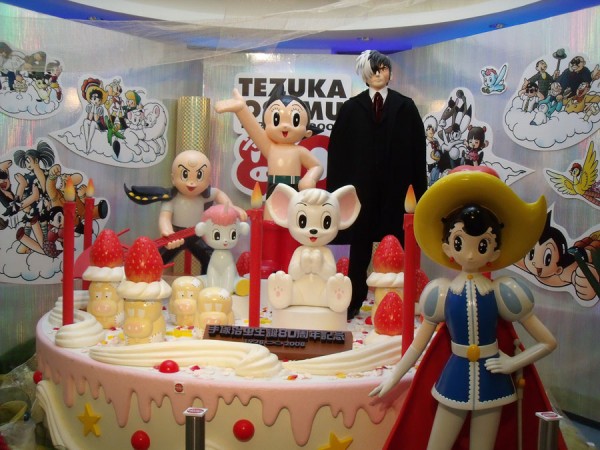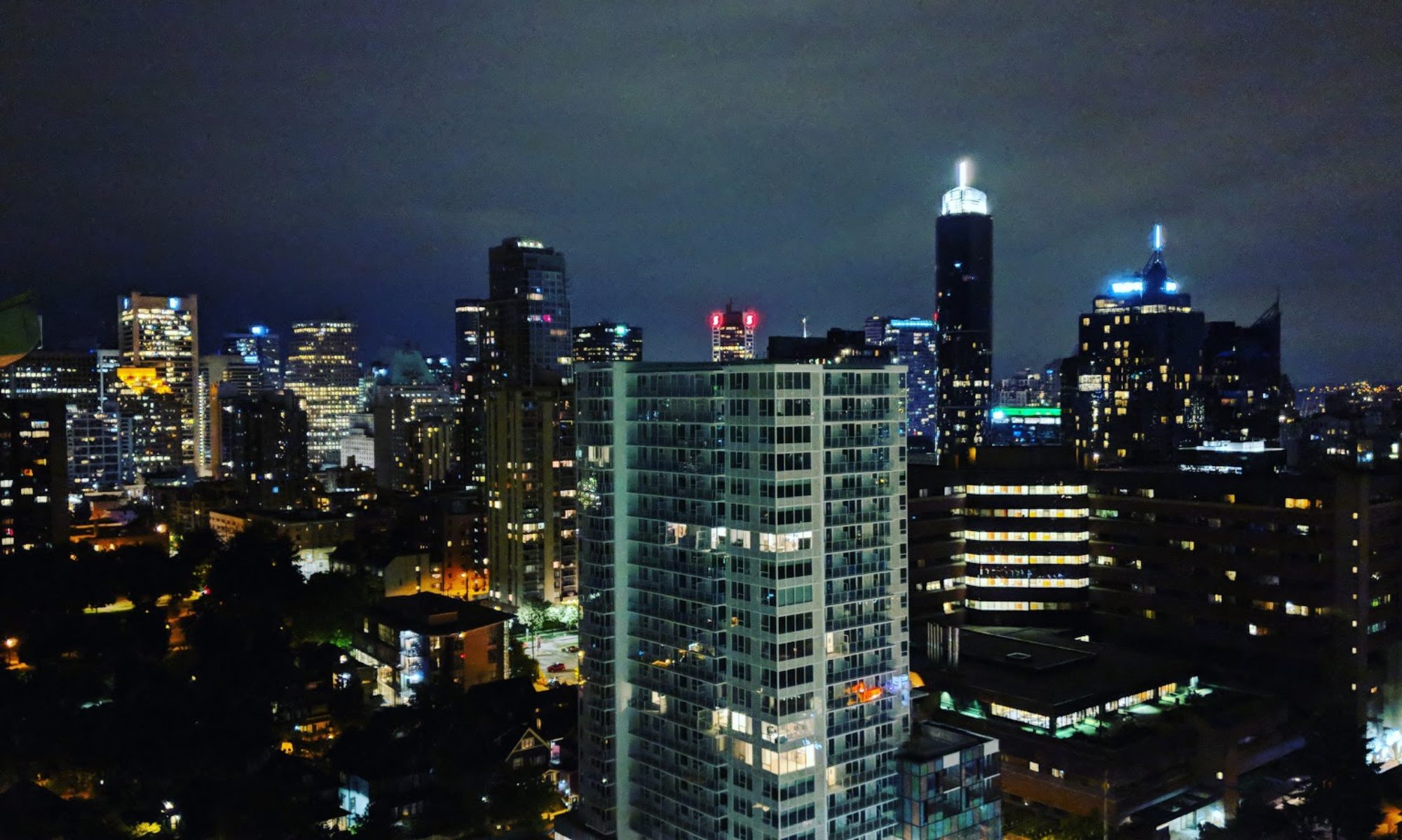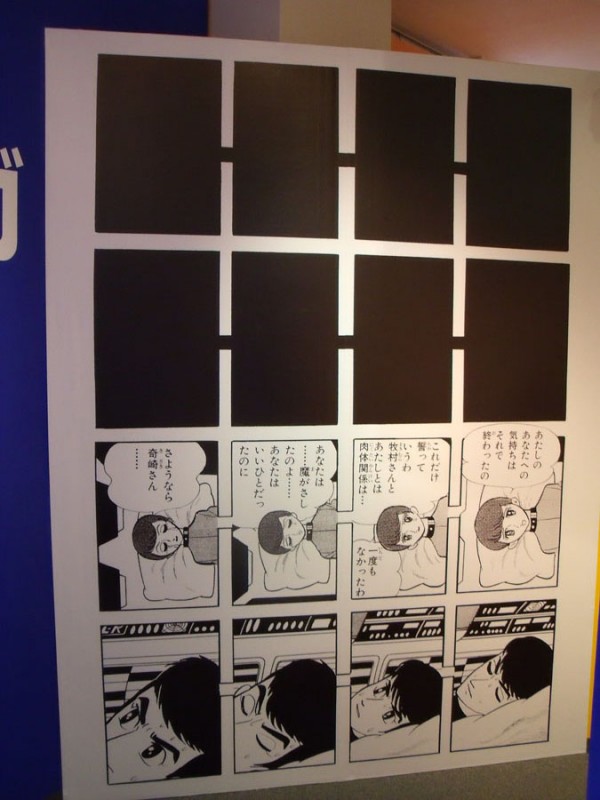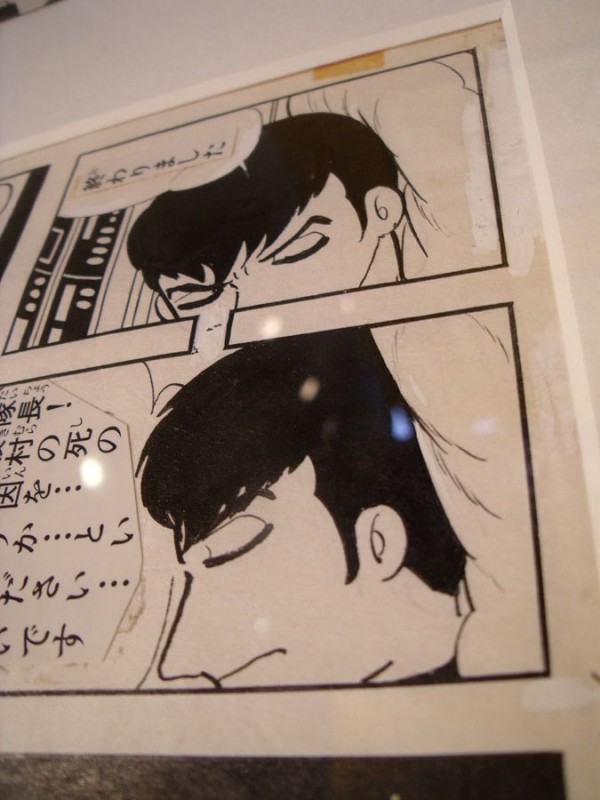
I absolutely had to go back to the Osamu Tezuka Manga Museum on my second trip to Japan. It was one of the highlights of my first trip, and while I felt like I really got a good run at it the first time through, Tezuka popping up all over the place on my second trip reminded me that, even if it was going to be out of the way, I knew I’d enjoy going. It turns out that I absolutely did. 🙂

The approach to the Museum was pretty great, but I feel like I covered that last time. I will say that when the familiar Phoenix statue and glass dome came into view, my heart swelled a little.

Love that statue.

The notice-board outside the museum announced… well, a title of an exhibition entirely in Japanese, and I didn’t have any idea what it said. I was able to figure out that it was an exhibition of Tezuka’s early works, with a specific focus on “Shin Takara Jima”, the first-ever Osamu Tezuka manga graphic novel. Oh, Shintakarajima translates into English as “New Treasure Island”.

The last time I was in this area, there was a permanent exhibition outlining just what the 100,000+ pages of manga that Tezuka had completed in his lifetime looked like. Now, it’s the introduction to the exhibit, which thanks to commenter “Kransom” I now know says:
“5 Periods of Tezuka Osamu: #5 / 1947: Tezuka Osamu’s Story Manga”
Looking at the website the other periods were (roughly)
1) “Exhibition of Eternal Stories – Final and Unfinished Works”
2) “1966-1973: Opened Eyes”
3) “2008: To a New World”
4) “1961: A Passion for Anime – The Age of Mushi Pro”
So apparently it was a multi-part, non-linear exploration of Tezuka’s manga career. This, the fifth part, was about the origins of Tezuka’s story manga… or basically “all the rare stuff we could find and display”.
Which, as exhibits, go, is FUCKING AWESOME.

These are digital printouts of some earlier, pre-Tezuka work. When I saw this I was kind of prepared to be let down… I mean, if it was just going to be reproductions, not that cool…




They did have a neat selection of pre-Tezuka manga graphic novels on display, and you can sort of see the natural evolution from strip comics and gags.
Interestingly (and stupidly) I did see some reproductions of these early pre-Tezuka books elsewhere on my trip, but did not buy them. Maybe next time?

A brief aside… Tezuka’s 80th birthday would’ve been in 2008, and the museum still had this little tribute room still set-up for him. This is the room that had Tezuka’s actual work-desk in it, last time I was there. Alright, back to it…!


The entrance to the exhibit was pretty awesome, starting with Shintakarajima and a bunch of the books under glass… as well as individual panels blown up everywhere… It was very immersive, and super-cool to see all the original hardcover graphic novels even if they were under glass.
It was also where I first noticed…
Original art! Aieeee! Click for larger on all of those btw.
So yeah, it was an informative and interesting exhibit (if you could read Japanese especially) and I liked seeing the books, and the blow-ups, and all of that. But the walls were completely lined with original artwork from Shintaka Rajima…! I mean COMPLETELY LINED. I didn’t seem to get a photo of it (somehow!?) but there were at least a hundred framed pieces of original Tezuka art from Shintakarajima up on the walls at this exhibit. It was awesome, I didn’t know what to look at first!
These pages of original art were remarkably well-preserved and beautiful… so much so that I wasn’t convinced that they were real, that they might have been high-quality reproductions or something. I mean, this was a story that came out in 1947, right? Well, I went and checked and… they’re from a re-drawn, later edition of the book, from the 1980s…! Tezuka’s notorious for redrawing panels, pages, whole scenes from his work, and apparently in this case he redrew THE ENTIRE MANGA. Here’s the story (it’s a good one):

New Treasure Island is based on an original story written by a veteran cartoonist in Osaka, Sakai Shichima. Tezuka Osamu, who was not yet THAT popular in 1947, adapted Shichima’s book into manga, which became Tezuka’s debut work (excluding some earlier gag manga and short newspaper strips). It became incredibly, incredibly popular, almost overnight, and sold more than 400,000 copies, laying the groundwork for the manga craze. While “New Treasure Island” was based on the work by Shichima, Tezuka had essentially created an original manuscript for the work. But before publication, substantial modifications were made by Sasaki Shichima, who cut nearly 60 pages and also changed some of the dialogue. Mostly, Shichima felt that some of what Tezuka had drawn wasn’t appropriate for children. While the book did very well, Tezuka basically stopped collaborating with people and eventually he refused to allow the work to be reprinted at all.

In the late 70s/early 80s, Kodansha undertook to reprint a line of books called “The Complete Works of Tezuka Osamu,” (which aren’t even close to complete btw, a little less than half of his work isn’t included), and Tezuka Osamu basically rewrote and redrew the entire thing from scratch so that it could be reprinted and to bring it closer to his vision for the original, and maybe to thumb his nost at Shichima a little too…! He also improved it dramatically, frankly. The “Complete Works” edition of Shintakarajima weighs in at 228 pages and was published in 1984 (5 years before Tezuka’s death), as compared to 192 pages in the original. In 2009, seemingly in conjunction with this exhibition, the original version of Shintakarajima was reprinted for what seems to be the first time in nearly 50 years, in an archival slipcase edition that set me back 20 bucks. Yeah, of course I bought it. 🙂 Totally worth it too, btw.
I also feel I should point out that “Shintakarajima” is written in romanji (English characters) on the cover of the book as Shintaka Rajima, but this is just an arbitrary phonetic break… Neither “Shintaka” or “Rajima” are real words. The title is three Kanji Characters, Shin (?), Takara (?), Jima (?), and on the original edition it’s also written out phonetically next to the big characters as 7 syllables, for the little kids who might not know their Kanji yet.
So yeah, all of the original art I saw on the walls? Tezuka going back and re-drawing himself from more than 35 years earlier, in a style even more influenced by filmic traditions than the original. As a point of comparison, here’s the first sequence from the original 1947 edition (scanned from my copy of the archival re-release):
The version that Tezuka ultimately redrew was even more cinematic, more “filmic”. So much so, in fact, that the panels that make up the beginning of Shintaka Rajima were set, one-at-a-time, on an HD monitor and run sort of like an animatic, or limited-animation cartoon, next to the original art at the museum. Luckily, I captured it on film! Check it out:
So this is the first chapter, presented a panel at a time. You can see that to tell the same amount of story in the new 1984 version, Tezuka took 45 panels(!) compared to 16(!) in the original one. While he did establish the dog in the story earlier (he basically comes out of nowhere in the original version…) that’s 3 times as many panels to tell the same bit of story. Scott McCloud oughtta work that into the revised edition of Understanding Comics… 😉
Anyway, this was a fascinating little discovery for me, I hope you enjoyed learning about it as much as I did. 🙂
Here’s a close up on a display case worth of early Tezuka graphic novels. It’s worth noting that many of these books, including Metropolis, Next World, and Lost World 1 & 2 were translated and released into English by Dark Horse in the early 2000s, and all four of them are currently “between printings”… Unfortunately. If you find’em, snap them up. I can’t imagine Dark Horse deciding to go back to print on them at any time in the near future.
Actually a quick check shows that Dark Horse’s online store has everything but Metropolis in stock for 40% off. Probably money well-spent…! They’re a little rough as works… unsophisticated maybe? But fascinating glimpses at early manga.
It’s kind of remarkable to see that some pages Tezuka got on the first or second go, almost no whiteout or paste-ups or anything. And some of them are just laboured over, you can see where Tezuka is trying to carve the illustrations out of the page, drawing and redrawing to get it as simple as it looks in the final…!
Following the original artwork, there was a bunch of history of manga that I could not read, but it was a fun (though a little cramped) way to move through the exhibition… and through the years! While the exhibition starts in 1947, it quickly moves through Tezuka’s career, highlighting his most popular works.
It led us into… more original art!
So this might be a bit difficult to tell, because there’s nothing in the picture for scale… but this is a wall, probably 8 feet tall, a reproduction of how the manga page appeared in print. I photographed it because it’s from my favourite story from Tezuka’s Phoenix series, “Space”, the fourth volume of the series. And on the wall opposite it was…
The original art for the page! Oh, how I covetted it. The page dates from 1968 or 1969…
You can click for larger if you like. 🙂
Here’s another page from that story (I believe).
More art!
Two things I find amazing:
– The paper has yellowed a little, but the white-out hasn’t, which makes the white-out practically GLOW… drawing attention to all of the mistakes! That’s gotta be brutal for an artist to see. 🙂
– The zipatone looks like it was laid down yesterday! These pages are basically 40 years old, and the zipatone (the grey dot patterns, pasted on a clear backing and cut into the shape of the grey areas above) is still clear and crisp. North American zipatone from even 20 years ago has started to yellow, badly. I don’t know what Japanese zipatone is made of, but damn, did they do it right!
Unfortunately, that’s everything for this visit. Sure, I went to the gift-shop, and took dozens of photos, but most of them are the same as my 2007 visit. Some of them will make it into “Random Japan” posts, so don’t feel too bad.
Luckily, robo-Tezuka is still working away in the basement, creating new dreams for kids of all ages.
What I really want to get across to you though, is that you really, really oughtta visit the Tezuka Manga Museum if you’re any kind of fan of manga or comics, it’s just amazing and inspirational to be in the place, and the proximity to original art (and so much of it) by a master of the form? Amazing.
See you next time!
– Christopher
Thanks to the following people who made this post possible with their Japanese language and research assistance:
– kransomwastaken on twitter
– Colin Turner, lastgaspbooks on twitter, &
– Scott Green @ AintItCoolNews, aicnanime on twitter.
– Some text adapted from now-defunct versions of the Osamu Tezuka website, at http://tezukaosamu.net/
– Don’t forget to check out the amazing resource, http://tezukainenglish.com/
























Hard to make out the top line, but it’s something like:
The Tezuka Osamu something something 5th
1947 Story Manga by Tezuka Osamu
I believe it’s
“5 Periods of Tezuka Osamu: #5 / 1947: Tezuka Osamu’s Story Manga”
Looking at the website the other periods were (roughly)
1) “Exhibition of Eternal Stories – Final and Unfinished Works”
2) “1966-1973: Opened Eyes”
3) “2008: To a New World”
4) “1961: A Passion for Anime – The Age of Mushi Pro”
Apparently I don’t know how to use HTML, haha. What I meant was:
A day later and not anymore. 🙁
Damn he was good.
Wow, this is awesome. Thanks for sharing, Chris. If I ever go to Japan, I’m definitely going to have to drag my wife to this museum and just glory in the presence of the Tezuka awesomeness.
Absolutely fantastic post and pictures, Chris! I visited the museum once in 2003, but didn’t get to see an exhibit as incredible as this. The thing that struck me most was that display board in the lobby that shows all of the series he was doing at any one time/year— including many years with 2-4 concurrent series.
I love this kind of post 🙂 Let me just say as a fellow Hi no Tori lover:
SEEING THAT MUCH ORIGINAL PHOENIX ART WOULD MAKE ME FAINT!
I love how you get the opportunity to see Tezuka’s white out skillz. ^_^
I bought the facsimile and the Complete Works versions of New Treasure Island, since I’m both a Tezuka geek and a creative-process geek.
After that extra-cinematic opening sequence, the Complete Works version settles down to being a panel-for-panel redraw for most of its length, but it adds a coda which parodies the original rather nicely (I can give a summary if you like).
Oh shit, those pages from Phoenix. I recognized the Space ones right away. That blew me away the first time I read it. I couldn’t believe it was from the 1960s. So innovative.
Thanks for this, Chris.
An Amazing photo-essay. Thanks!
wait… let me quote this: “it’s kind of remarkable to see that some pages Tezuka got on the first or second go, almost no whiteout or paste-ups or anything”
are you saying that Tezuka worked directly in ink for most of these pages? no pencils? at all? *aghast*
That’s my favorite Phoenix story too.